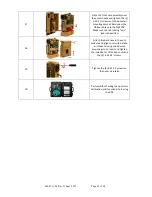
906-0731-04 Rev. B Sept. 2012
Page 7 of 68
CAUTION!
Internal components are susceptible to damage from static discharge. Do not remove device
covers.
NOTE:
This Operation Manual is not meant to supersede any controlling standard operating procedure
regarding the safe use of assisted ventilation.
NOTE:
Follow all governing regulations regarding the disposal of any part of this medical device.
NOTE:
Follow all governing regulations regarding the handling of materials contaminated by body fluids.
NOTE:
Follow all governing regulations regarding shipment of the Li batteries.
Pulse Oximeter Specific Warnings And Cautions
WARNING!
A pulse oximeter should not be used as an apnea monitor.
WARNING!
A pulse oximeter should be considered an early warning device. As a trend towards patient
deoxygenation is indicated, blood samples should be analyzed by a laboratory co-oximeter to completely
understand the patient’s condition.
WARNING!
MEASUREMENTS
If the accuracy of any measurement does not seem reasonable, first check the patient’s vital signs by
alternate means and then check the pulse oximeter for proper functioning.
Inaccurate measurements may be caused by:
Incorrect sensor application or use
Significant levels of dysfunctional hemoglobin (e.g., carboxyhemoglobin or methemoglobin)
Intravascular dyes such as indocyanine green or methylene blue
Exposure to excessive illumination, such as surgical lamps (especially ones with a xenon light source),
bilirubin lamps, fluorescent lights, infrared heating lamps, or direct sunlight (exposure to excessive
illumination can be corrected by covering the sensor with a dark or opaque material)
Excessive patient movement
Venous pulsations
Placement of a sensor on an extremity with a blood pressure cuff, arterial catheter, or intravascular
line
The pulse oximeter can be used during defibrillation, but the readings may be inaccurate for a short
time.
WARNING!
Interfering Substances:
Carboxyhemoglobin may erroneously increase readings. The level of
increase is approximately equal to the amount of carboxyhemoglobin present. Dyes, or any substance
containing dyes, that change usual arterial pigmentation may cause erroneous readings.
WARNING!
ALARMS Check alarm limits each time the pulse oximeter is used to ensure that they are
appropriate for the patient being monitored.
WARNING!
Loss of pulse signal can occur in any of the following situations:
The sensor is too tight
There is excessive illumination from light sources such as a surgical lamp, a bilirubin lamp, or sunlight
A blood pressure cuff is inflated on the same extremity as the one with a SpO
2
sensor attached
The patient has hypotension, severe vasoconstriction, severe anemia, or hypothermia
There is arterial occlusion proximal to the sensor
The patient is in cardiac arrest or is in shock








































